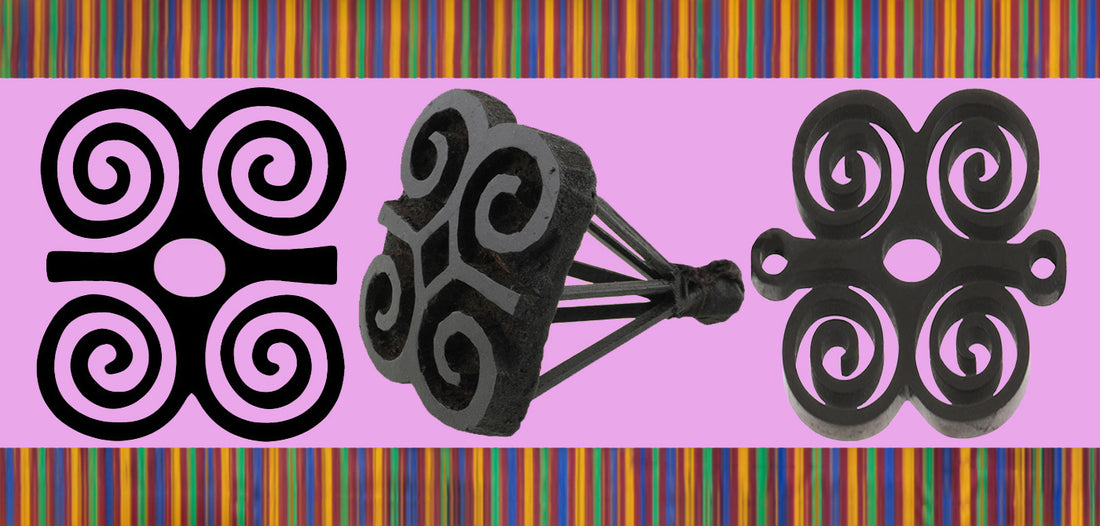
Dwennimmen - The Adinkra Symbol of Humility and Strength (Ram's Horns)
Share
Dwennimmen - The Adinkra Symbol of Humility and Strength
Dwennimmen (pronounced "dwen-nim-men"), meaning "ram's horns" in Twi, is a powerful Adinkra symbol representing both humility and strength. This symbol is deeply rooted in the cultural heritage of the Akan people, particularly the Asante of Ghana. The image of the ram’s horns embodies the balance of being meek and humble yet strong and fierce when necessary.

Symbolism and Meaning
The Dwennimmen symbol combines the attributes of the ram’s horns to depict a dual concept. The ram, an animal known for its strength and aggressiveness during combat, also displays a certain gentleness and humility, especially in the presence of its shepherd. This juxtaposition of traits is what the symbol emphasizes: the importance of balancing power with humility.
The proverb associated with Dwennimmen is: "It is the heart and not the horns that leads a ram to bully," underscoring the significance of inner strength and character over physical power.

Historical and Cultural Context
Adinkra symbols are an integral part of Akan culture, often used to convey complex philosophical concepts and cultural values. Originating from the Gyaman people of Côte d'Ivoire and adopted by the Asante, these symbols are traditionally used in fabric design, pottery, logos, and architectural elements. The term "Adinkra" itself means "goodbye" or "farewell," reflecting its initial use in funeral attire to bid farewell to the departed.

Adinkra cloth stamped with Dwemmimmen symbol
The practice of using these symbols dates back to the early 19th century when King Adinkra of Gyaman was defeated by the Asantehene, Nana Osei Bonsu-Panyin, for attempting to replicate the sacred Golden Stool. The Adinkra cloth taken from King Adinkra during his capture became a cultural treasure and a significant medium for these symbols.

Applications in Modern Times
In contemporary Ghanaian society, Dwennimmen and other Adinkra symbols are not limited to ceremonial clothing but have found their way into various forms of art and everyday items. They are often seen in:
- Fashion: Traditional and modern clothing designs incorporate Adinkra symbols to convey messages and cultural heritage.

- Musical Instruments: Adinkra symbols are carved or painted onto traditional musical instruments, adding cultural significance and beauty to these items.

- Jewelry: Adinkra symbols are used in various jewelry pieces, allowing individuals to wear and display cultural messages and values.

Proverbs and Wisdom
The Dwennimmen symbol, like many Adinkra symbols, is accompanied by proverbs that reflect its deeper meaning. A popular Akan proverb associated with this symbol is "Humility is the mother of all virtues; where there is humility, there is strength." This proverb highlights the cultural importance placed on maintaining humility regardless of one’s strength or position.
Additional Proverbs Associated with Dwennimmen
- "It is the heart and not the horns that lead a ram to bully." - This emphasizes the importance of inner strength and character over mere physical power.
- "A humble person is the wise person." - This stresses that wisdom comes from humility, not arrogance or brute strength.
- "Humility conquers pride." - This suggests that true strength lies in being humble, which ultimately triumphs over pride.
- "The ram may have horns, but it listens to the shepherd." - This implies that even those with great power or strength must be humble enough to follow guidance and wisdom.
- "Strength without humility is like a tree without roots." - This highlights that strength must be grounded in humility to be meaningful and enduring.
- "True strength is shown through humility and not through the display of power." - This teaches that real strength is demonstrated by humility and self-restraint rather than by aggressive displays of power.
- "A humble heart gains more than a proud head." - This suggests that a person who is humble will achieve more and be more respected than one who is proud and arrogant.
- "The horn may be strong, but it is the heart that leads." - This emphasizes that true strength comes from one's character and heart, not just physical might.
Visual Representation
The visual representation of Dwennimmen is both simple and profound. The symbol consists of two stylized ram's horns that curve outward and downward, forming a symmetrical shape. This design is often stamped or embroidered on fabrics, carved into wooden objects, and printed on various materials.

Conclusion
Dwennimmen is a timeless symbol that beautifully encapsulates the values of strength and humility. Its continued use in modern Ghanaian culture signifies the enduring relevance of these principles. By understanding and appreciating symbols like Dwennimmen, we gain deeper insights into the rich cultural tapestry of the Akan people and their enduring wisdom.
To view a selection of Adinkra art artifacts, please check our page

